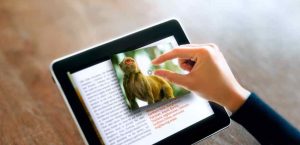We believe that digital technology has the capacity to change things, and we use it as a key part of making ecological books. Everyone love physical books and the way they are manufactured in a way that is beneficial for the environment. But we also know that digital platforms, especially gadgets like the iPad, are incredibly vital for making our influence on the environment as a whole smaller.
The Digital Dimension of Ecological Book Production
 Digital has Eco-Friendly Benefits that Help us Leave Less of a Physical Footprint
Digital has Eco-Friendly Benefits that Help us Leave Less of a Physical Footprint
The iPad and other tablets are good for the environment since they reduce the demand for physical resources at different points in a book’s life. We support virtual proofing, which lets authors, editors, and designers look over and approve layouts online. This cuts down on the amount of paper, ink, and carbon emissions that come from delivering many physical revisions over long distances. We also put a lot of effort into making and sharing other digital assets, such review copies and promotional materials, all online. This lets them spread throughout the world right away without wasting any physical space. This purposeful move towards digital-first processes for some phases of publication greatly cuts down on the need for new materials and the energy that goes into traditional printing and distribution.
Getting Involved Online: Creating a Community for Green Literature
Our digital presence isn’t just about making things work well; it’s also about creating an active internet community that cares regarding reading in an approach that doesn’t hurt the environment. You can learn a lot and be open on our web page and social media accounts. We write interesting articles that talk about the environmental benefits of making books in an eco-friendly way. We tell stories about how we employ papers made from sustainable materials, vegetable-based inks, and energy-efficient methods. We give readers clear, correct information about our sustainability activities and certifications so they can make wise choices. Our “online” strategy also includes social media, online events, and interactive campaigns that let us talk to the audience and participants all around the world. This gives individuals from all over the world a sense of being connected around environmentally friendly literature, which, including our Filipino readers in Central Luzon, connect, share ideas, and work together to make green publishing initiatives more popular.
Sustainability Based on Data: Measuring and Improving Impact
Our internet strategy gives us unique access to valuable data that lets us constantly measure and improve our impact on the environment. The team keeps a close eye on statistics that compares how much people read digital books to how much they buy physical books. This study gives us useful information about what the audience wants and helps us make the most use of our resources. Also, the corporation carefully looks at the replies to its online messages about sustainability to see how well its communication techniques are working. This data-driven approach helps us develop better plans, come up with new ways to make our operations more eco-friendly, and make wise decisions that help the supply chain last longer.
Final Notes
We are actively working on a digital plan for a more environmentally friendly future in publishing at “iPad.” We are not just greatly lowering our environmental impact, but we are also making ecological book creation more widely available and having a bigger beneficial effect by using technology to make things more efficient, building an active online community, and using data to make things better all the time. Our all-encompassing online strategy shows that the way to a sustainable literary world is through new ideas, openness, and a strong, unwavering dedication to engaging with readers who share our vision for a healthy planet.
Turn pages, not the planet. #GreenBooks
https://www.ecolibris.net



 Digital has Eco-Friendly Benefits that Help us Leave Less of a Physical Footprint
Digital has Eco-Friendly Benefits that Help us Leave Less of a Physical Footprint